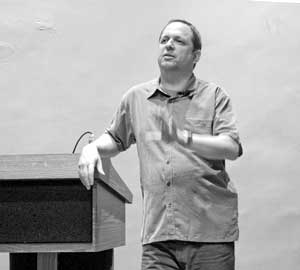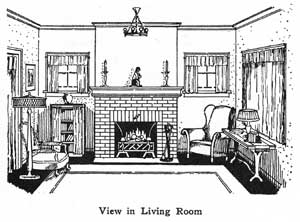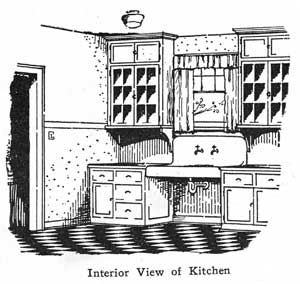Small Home Gazette, Winter 2010
How Authentic Is Your Bungalow?

Bo Sullivan, owner of Arcalus Period Design, speaking to the Twin Cities Bungalow Club in September 2009.
As a follow-up, we asked Sullivan a series of questions designed to help you make your bungalow more charming, comfortable and authentic.
Small Home Gazette: What are mistaken modern-day perceptions about how bungalows were originally furnished?
Bo Sullivan: I’m not sure I’d call them mistaken perceptions as much as unexamined assumptions—things we often take for granted when enhancing bungalows today that actually contradict the patterns of the day—the quality of electric light, the look of kitchens, and character of bathrooms.
 The years 1911 and 1912 were watershed years for interior lighting, with the commercial introduction of the tungsten-filament light bulb. Over the next few years, this bulb would gradually replace Edison’s carbon-filament bulb in homes across the country. With an output of more than 2.5 times the light for the same amount of electricity, this bulb also ushered in the era of shower- and bowl-style light fixtures. So the bungalow was conceived and originally outfitted in the warm, dim light of carbon filaments. Turn your dimmer switch down more than halfway to imagine the quality of light that early bungalow owners would have lived by, and suddenly those busy wallpapers with gaudy metallic inks and glitter outlines become shimmering layers of subtly, the table lamp beside the Morris chair is a necessary companion for cozy reading, the fireplace throws glowing flickering light around the room, and the dinner table is an intimate pool of soft illumination in a cozy home. It wasn’t until the 1920s that the brightly lit types of interiors that we take for granted today were more commonplace.
The years 1911 and 1912 were watershed years for interior lighting, with the commercial introduction of the tungsten-filament light bulb. Over the next few years, this bulb would gradually replace Edison’s carbon-filament bulb in homes across the country. With an output of more than 2.5 times the light for the same amount of electricity, this bulb also ushered in the era of shower- and bowl-style light fixtures. So the bungalow was conceived and originally outfitted in the warm, dim light of carbon filaments. Turn your dimmer switch down more than halfway to imagine the quality of light that early bungalow owners would have lived by, and suddenly those busy wallpapers with gaudy metallic inks and glitter outlines become shimmering layers of subtly, the table lamp beside the Morris chair is a necessary companion for cozy reading, the fireplace throws glowing flickering light around the room, and the dinner table is an intimate pool of soft illumination in a cozy home. It wasn’t until the 1920s that the brightly lit types of interiors that we take for granted today were more commonplace.
 The era of the bungalow was also the era of slowly evolving kitchens, but kitchens were still far less outfitted with the extensive cabinetry and boxy appliances we take for granted today. Kitchen furniture tended toward the portable character of center work tables and Hoosier cabinets, with minimal built-in cabinetry, stoves and sinks up on legs, and the work areas oriented to take advantage of natural light. Countertop appliances were fewer and people simply owned a lot less stuff. And cabinets in kitchens were either humble woods like fir or birch or painted—the “Craftsman” kitchen of today with cherry cabinets, stainless appliances, and granite countertops is beautiful and functional, but truthfully reflects little of the character of period bungalow kitchens.
The era of the bungalow was also the era of slowly evolving kitchens, but kitchens were still far less outfitted with the extensive cabinetry and boxy appliances we take for granted today. Kitchen furniture tended toward the portable character of center work tables and Hoosier cabinets, with minimal built-in cabinetry, stoves and sinks up on legs, and the work areas oriented to take advantage of natural light. Countertop appliances were fewer and people simply owned a lot less stuff. And cabinets in kitchens were either humble woods like fir or birch or painted—the “Craftsman” kitchen of today with cherry cabinets, stainless appliances, and granite countertops is beautiful and functional, but truthfully reflects little of the character of period bungalow kitchens.
Also evolving during the era of the bungalow was how people viewed and used the bathroom. Most bungalows were considered modern if they had even one indoor bathroom. Tubs were rarely outfitted with showers, and bathing itself was not seen as a daily hygienic necessity like today. Hot water heaters were small in capacity, rooms were colder, and washing the dirty towels was no fun at all—there wasn’t a lot of incentive for bathing regularly. In addition, larger families lived in smaller houses; bathrooms were cluttered with far fewer bottles of shampoo, shaving cream, bubble bath, and hair gel; and much of the routine primping happened in the bedroom at a dressing table rather than in front of the medicine cabinet mirror (though I do suspect that the medicine cabinet was as full of various remedies as now). Other detail differences? Many bungalow bathrooms were fitted for toilet paper in stacks of flat sheets rather than on a roll, and terrycloth towels would not become popular until later in the century. And every household with a man living in it had a spot for a small cup and shaving brush as well as a small hook on the bathroom wall somewhere for the ubiquitous razor strop. The bathroom simply wasn’t the spiritual retreat or stylish showplace that it is in today’s homes. Not that any of us want to go back to straight razors and sheet toilet paper…
SHG: Most bungalow dwellers don’t want to live in a museum, yet they want their interiors to capture the flavor of the era their home was built in. What elements best convey this flavor?
Sullivan: Perhaps the easiest way to connect with an era is to have a selective number of objects in the home that reflect the technologies and manufacturing methods of the day. These might be functional items like sewing tables, picture frames, wall cupboards or table lamps. Or they could be purely decorative such as boxes or cans with vintage labels or packaging, an original calendar from the date of your house, or an obsolete appliance like a toaster, hair curler, or telephone. Items that have an authentic patina or an original finish (like antique or oxidized copper) convey a subtle emotional quality that goes a long way. A few old books with beautiful spines or covers, a vintage textile pillow or table scarf, and advertising ephemera also make rich accents and can be super fun to hunt for online or in antique shops.
SHG: I’ve done some research, and find that many original bungalow fixtures, furniture, and decorative objects were downright ugly. Are there other options?
Sullivan: One look at a Sears catalog from the 1910s will show an amazing range of products available to the typical bungalow owner. Add to this all the items made and sold by hundreds of other companies (many local or regional) and then assume that most folks were inheriting a few things from their families or previous homes. Colonial and medieval trends mixed with Arts & Crafts and lingering Victorian-era motifs—only the most earnest and snobbish set themselves and their homes up on the pedestal of stylistic purity.
The real world then, just like today, was eclectic and messy. There was pretty much an endless array of choice, and no rules about what you could and couldn’t put together except the boundaries of personal taste. So the question is really the same today as it was then : “What makes for an interior that works?” rather than “What makes for an interior that is ‘right’?”
The answer to this question is very personal but might follow three basic principles. My interior is: A) welcoming, functional and comfortable; B) unified through harmonious colors and design qualities; and C) expresses my unique ideas of beauty and delight.
SHG: I’m curious about how my home’s original owners lived. Where can I find details about what they ate, what they planted in their yards, and what they did on long winter evenings?
Sullivan: Contemporary magazines are perhaps the best window into the tastes and habits of the nation at any given time. And just as different magazines today have different audiences, so did the periodicals of the day. It can be fun to imagine which publications you would have subscribed to: The Philistine, Good Housekeeping, Harper’s, Photoplay, Popular Mechanics, Saturday Evening Post, Garden Magazine, Cosmopolitan, National Geographic, Vogue, Ladies’ Home Journal, or Life?
SHG: I’ve seen a few period images of bungalow interiors, and they don’t always look like what’s promoted in present-day magazines and stores. Where can I find authentic views of bungalow interiors for different ideas and inspiration?
Sullivan: There are three primary sources for views of original bungalow interiors: old photographs, original magazines, and vintage trade catalogs and decorating books. Each of these categories offers insights in different, and complementary, ways. The biggest obstacle for all three is finding those rare and compelling images in color that really reach out and engage our contemporary senses.
Unfortunately, there are not a lot of easy sources for finding these images today. Many local and institutional libraries maintain collections of historic photographs that can be explored, but I am not aware of any new books that collect such images in a single, concentrated volume. Old magazines can still be found in bookstores, antiques shops, online, or at estate and yard sales, and prices aren’t unreasonable. It is an advantage to be able to flip through the pages before purchasing to see if an issue contains any good material. Trade catalogs and decor books can most easily be picked up on eBay or from online antique book dealers. On eBay, competition can be fierce, and fortune favors the dedicated searcher, as some of the best deals are the items most poorly described. There are also dealers on eBay that specialize in reprinting vintage books and catalogs, including sellers with the user names emisc and vintage_rvs.
The Arcalus archive and Rejuvenation research library includes more than 2000 original catalogs, decorating books, salesman samples, magazines and photographs documenting the American building arts between 1870 and 1970. If you have a specific area of interest you are researching, or are working on a project where a meaningful connection to the past is important, Arcalus is a unique consulting resource for collaboration and support. Visit Arcalus online at http://arcalus.com.











